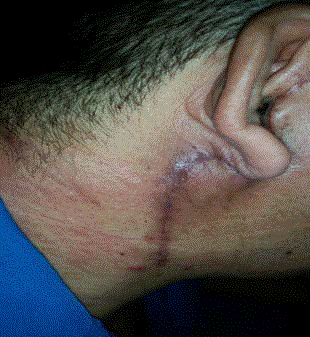Clinical Image
Rare Parotid Salivary Fistula Post Superficial Parotidectomy
Lorna Ting1* and YT Liew2
1Department of Otorhinolaryngology, Queen Elizabeth Hospital, Sabah, Malaysia
2Department of Otorhinolaryngology, Head & Neck Surgery, University Malaya Medical Centre, Malaysia
*Corresponding author: Lorna Ting, Department of Otorhinolaryngology, Queen Elizabeth Hospital, Sabah, Malaysia
Published: 30 Apr, 2018
Cite this article as: Ting L, Liew YT. Rare Parotid Salivary
Fistula Post Superficial Parotidectomy.
Clin Surg. 2018; 3: 1955.
Clinical Image
A 67 year old gentleman presented to our otorhinolaryngology clinic with right parotid swelling for 6 months. It gradually increased in size and was painless. It was 6 cm by 5 cm in size with intact facial nerve function. Cervical lymphadenopathy was absent. Fine needle aspiration cytology showed pleomorphic adenoma. He underwent an uneventful superficial parotidectomy via modified Blair incision and vacuum drain was inserted post-operatively. Amount of drainage was minimal at day 3 and drain was removed. At post-operative day 12, he complained of salivary like fluid coming out from posterior edge of wound (Figure 1). There was no associated flushing and erythema of overlying skin. The fluid leakage worsened upon taking meals. Fluid analysis showed high concentration of amylase which is consistent with saliva. He was just managed conservatively with ‘watch and wait’ policy and the leakage disappeared 3 weeks later. Salivary fistula is a rare complication from superficial parotidectomy. Its incidence was reported at about 4% after superficial parotidectomy [1]. Deeper part of residual parotid tissues will continually secrete saliva and accumulates as sialocele. When secretion is more than capacity of drainage via normal Stenson’s duct, fistula forms. It can be prevented by placing Superficial Musculoaponeurotic System (SMAS) to ameliorate defect after parotidectomy, which was proven to reduce risk of sialocele, salivary fistula, and Frey’s syndrome [2]. Other treatment options are Botulinumtoxin A injection [3], topical application anticholinergic drugs, tympanic neurectomy. More than 90% will heal spontaneously without any intervention.
Figure 1
References
- Laskawi R, Drobik C, Schonebeck C. Up-to-date report of botulinum toxin type A treatment in patients with gustatory sweating (Frey’s syndrome). Laryngoscope. 1998;108(3):381-4.
- Cesteleyn L, Helman J, King S, Van de Vyvere G. Temporoparietal fascia flaps and superficial musculoaponeurotic system plication in parotid surgery reduces Frey’s syndrome. J Oral Maxillofac Surg. 2002;60(11):1284-97.
- Lai AT, Chow TL, Kwok SP. Management of salivary fistula with botulinum toxin type A. Ann Coll Surg H K 2001;5:156-7.

